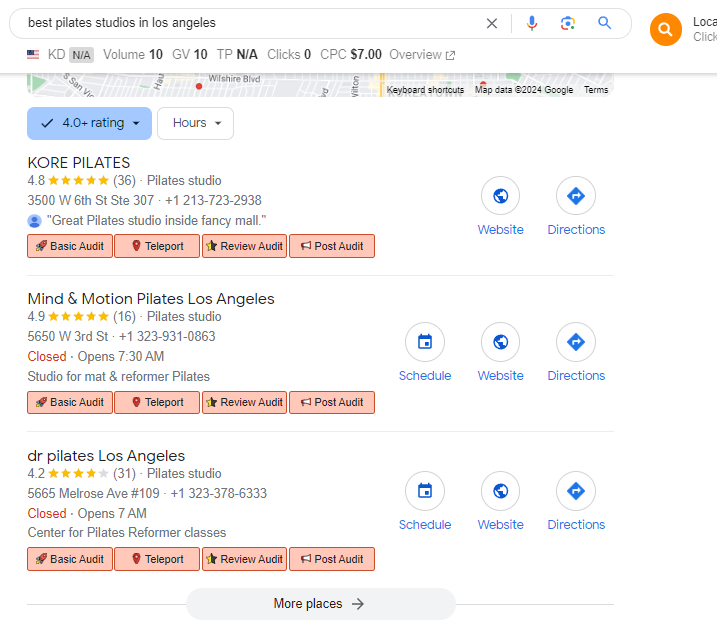What is SEO? is the process of improving your websites to rank higher on search engine results pages (SERPs).
This is a reliable and cost-effective marketing method that helps increase website traffic and increase conversion rates.
To better understand SEO, this article will walk you through the fundamentals of search engines and SEO explain how search algorithms work and introduce the various factors that influence your website rankings.
After this article, you’ll discover recommended SEO techniques and many resources to expand your understanding of SEO.
What Factors Affect SEO and are Most Important?
Several factors converge to shape online visibility key factors include relevant content, strategic keyword integration and user-friendly website design.
Backlinks, signal reliability and page load speed are also essential. Search engines value mobile responsiveness with an emphasis on accessibility.
User experience measured by bounce rate and click-through rate has a significant impact on rankings.
Consistency of quality updates and adherence to search engine guidelines will strengthen SEO efforts.
Ultimately, a harmonious combination of content technical prowess and user-centricity emerges as the foundation of effective SEO ensuring that websites resonate with algorithms and audiences.
How Does SEO Work?
SEO or Search Engine Optimization improves a website visibility on search engines. This involves optimizing content, using relevant keywords and improving site structure.
Search engines evaluate various factors such as keywords, backlinks and user experience to rank pages.
Creating quality content, mobile optimization and regular updates contribute to higher rankings.
SEO aims to align a website with search engine algorithms ensuring that it appears prominently in relevant searches, thereby increasing organic traffic and visibility.
It is an ongoing process that requires strategic planning and constant efforts to improve a website’s search engine performance.
What Are the Different Types of SEO?

Search engine optimization (SEO) is an important pillar for improving your online visibility and reaching a wider audience.
However, SEO is not a single strategy it includes many different types each serving a unique purpose.
Let’s explore the different aspects of SEO that contribute to a well-rounded online presence.
On-page SEO
Effective on-page SEO is crucial for boosting the visibility of individual pages on search engine results pages (SERPs).
This optimization process involves enhancing both the content and HTML source code of a webpage, including elements such as title tags, header tags, and meta descriptions.
If your website is powered by WordPress, leveraging reputable SEO plugins can streamline and enhance these optimization efforts.
The primary goal of on-page SEO is to create a seamless experience for both users and search engine crawlers. By fine-tuning various elements of your page you can make it more appealing to users while also ensuring that search engine algorithms can easily understand and index your content for relevant search queries.
1. Site Content
Google relies on a framework known as E-A-T (Expertise, Authoritativeness and Trustworthiness) to evaluate the quality of content, pages and websites.
Prioritizing high-quality content authored by reliable individuals and hosted on trustworthy websites is essential for achieving higher rankings in search results.
Therefore, ensuring that your page aligns with these criteria is crucial for success.
2. Keyword Optimization
Strategic placement of keywords within your content is vital for helping search algorithms identify the type of information your page provides.
Conduct thorough keyword research using tools such as Ahrefs Keywords Explorer or Google Keyword Planner to identify target keywords.
However, it’s essential to maintain a natural keyword distribution to avoid penalties for keyword stuffing from search engines like Google.
3. Title Tags
The title tag, also referred to as the page title, serves as a clickable link visible on SERPs.
Crafting a well-written title is crucial for conveying the page’s relevance to user search intent.
A concise title that incorporates relevant keywords can attract more clicks and drive increased traffic to your page.
Search engines tend to favor pages with well-optimized titles, ranking them higher in organic search results.
4. Header Tags
Dividing your content into sections using header tags not only improves the user experience but also aids web crawlers in indexing your page effectively.
Search engines use header tags as a guide when looking for relevant information in response to user search queries.
Organizing your content with these tags increases the likelihood of your page appearing higher in search results.
5. Image Alt Text
Alt text or alternate text, provides a description of images for users who may be visually impaired or in situations where images cannot be displayed.
This attribute informs search engines that the image is valuable content on your page.
Additionally, it opens up additional ranking opportunities, as images may appear in Google image search results.
6. Meta Description
The meta description is a brief summary of a page’s content that appears on SERPs alongside the page title and URL.
Including relevant keywords and accurately describing the content helps attract users and reduces bounce rates when the page satisfies their intent.
Crafting a compelling meta description can significantly impact click-through rates.
Off-page SEO
Improving your website’s visibility on search engine results pages involves more than just optimizing website elements.
Off-page SEO an important part of any overall search engine optimization strategy focuses on activities performed outside of your website.
The goal is to establish credibility, authority, and relevance in the eyes of search engines and users.
Here we will look at key off-page SEO factors that can improve your website rankings and online presence.
Link Building
One of the fundamental pillars of off-page SEO is link building this involves getting links from external websites to your website.
Each incoming link constitutes a vote of confidence in the eyes of search engines. However, quality trumps quantity in this aspect.
It’s important to cultivate links from reputable and authoritative websites in your industry.
Google’s algorithm values high-quality backlinks, which contribute significantly to your website’s credibility and rankings.
Social Media Marketing
A strong social media presence is essential for modern businesses. In addition to being a platform to connect with your audience social media also plays a role in off-page SEO.
Compelling content shared on platforms like Facebook, Twitter and Instagram not only reaches a wider audience but also signals to search engines that your website is relevant and reputable.
Social signals help build trust and authority, factors that influence search rankings.
Influencer Outreach
Collaborating with influential people or brands can significantly boost your off-page SEO efforts. By leveraging the reach and credibility of influencers, your brand can reach new audiences.
When influencers endorse your products or services, it not only improves your reputation but also drives traffic to your website.
Building relationships with influencers in your industry can lead to valuable partnerships that benefit both parties.
Join Forums
Participating in online forums like Quora, Reddit, and Stack Overflow is one way to promote your website.
Actively participating in relevant discussions allows you to demonstrate your expertise and build credibility.
Including a link to your site in a natural, non-promotional way can drive organic search traffic.
Forums provide a unique opportunity to connect with your target audience, answer their questions and establish your brand as a knowledgeable authority in the field.
Technical SEO
One crucial aspect that often takes center stage is technical SEO this facet focuses on optimizing the technical foundation of your website to enhance its search engine performance.
Technical Audit SEO involves optimizing the technical aspects of a website to make it more accessible and attractive to search engines.
This optimization, while not directly influencing content plays a pivotal role in how search engines index and rank a site.
Some key components of Technical SEO include.
- Crawlability and Indexing
- Ensure search engine bots can easily crawl and index your website.
- Utilize a robots.txt file to guide crawlers and prevent indexing of irrelevant content.
- Create and submit a sitemap to search engines for efficient indexing.
- Site Speed and Performance
- Page loading speed directly impacts user experience and search rankings.
- Optimize images, minify CSS and JavaScript, and leverage browser caching to enhance site speed.
- Utilize Content Delivery Networks (CDNs) for faster loading times across different geographical locations.
- Mobile-Friendliness
- With mobile searches on the rise, having a mobile-friendly website is imperative.
- Implement responsive design to ensure a seamless experience across various devices.
- Test your website’s mobile-friendliness using tools like Google’s Mobile-Friendly Test.
- Technical Site Structure
- Use a clear and logical URL structure that reflects your site’s hierarchy.
- Employ proper header tags (H1, H2, H3) for content organization and readability.
- Create a user-friendly navigation structure that enhances both user experience and search engine understanding.
- HTTPS and Security
- Secure your website with HTTPS to ensure data encryption and build trust with users.
- Regularly update and patch your website’s security to protect against potential vulnerabilities.
- Search engines often prioritize secure websites, influencing rankings.
- Canonicalization
- Use canonical tags to address duplicate content issues and consolidate page authority.
- Specify the preferred version of a URL to guide search engines in ranking the correct page.
Local SEO
Local SEO, or Local Search Engine Optimization, plays a pivotal role in enhancing the visibility of businesses within specific geographic areas.

By optimizing various aspects, businesses can secure prime spots on local search results, gaining exposure and promoting their brands, products and services to the local community.
This article explores the key elements of local SEO and how businesses can leverage them to secure a prominent position in local search results.
When users search for services or products in their vicinity, search engines identify their locations through IP addresses and present relevant results.
Local search results often feature a map followed by three organic search results. For instance, a search for “best pilates in los angeles” might display three local businesses along with snippets of their locations on Google Maps as the top results.
Key Aspects of Local SEO
- Google My Business (GMB) Profile
- Creating a Google My Business account is essential for local SEO success. The map displayed in the top results on Google local search is derived from GMB profiles.
- Ensure that your GMB profile is complete and accurate, including crucial information such as your business name, address, and phone number (NAP). These details serve as ranking factors.
- Google ranks GMB profiles based on distance, prominence, and relevance to the user’s search query.
- Local Keyword Research
- Integrating local keywords into your website’s pages can significantly boost your rankings on search engine results pages (SERPs).
- Compile a list of keywords that describe your products or services, and then add location-based modifiers. Utilize SEO tools like Ahrefs to identify high-performing keywords based on search volume and difficulty.
- Localized Content
- Tailor your content to target a specific local demographic. Creating locally relevant content that addresses the needs of your target audience is crucial.
- Develop a range of content, including blog posts, guides, case studies, and recommendations, aligning with your business niche and the interests of your local audience.
- Customer Reviews
- Positive customer reviews contribute to building trust in your business, and search engines take notice.
- Actively encourage customers to leave reviews through emails or dedicated review pages. Monitor and respond to reviews promptly, as customer feedback can influence local search rankings.
Best 5 SEO Ways to Improve Your Google Rankings
Search Engine Optimization (SEO) plays a pivotal role in enhancing your site’s visibility and attracting organic traffic to help you boost your Google rankings.
Start with Keyword Research and Optimization
Effective keyword research is the cornerstone of successful SEO. Identify relevant keywords and phrases that potential users are likely to search for.
Utilize tools like Google Keyword Planner or SEMrush to discover high-volume, low-competition keywords. Once identified, strategically integrate these keywords into your website’s content, meta tags, and headers.
This will signal to search engines that your content is relevant to users’ queries, improving your chances of ranking higher.
Create a High-Quality Content
Content is king in the digital realm and Google rewards websites that provide valuable, relevant and engaging content.
Regularly update your website with fresh, informative, and unique content that caters to the needs of your target audience.
Use a variety of content formats, such as blog posts, articles, infographics and videos to keep your audience engaged.
Quality content not only attracts visitors but also encourages other websites to link to your pages, boosting your site’s authority and search engine rankings.
Make Sure it Mobile Friendly
With the increasing prevalence of mobile devices Google prioritizes mobile-friendly websites in its rankings.
Ensure that your website is responsive and optimized for various screen sizes.
Google’s mobile-first indexing means that the mobile version of your site is considered the primary version for indexing and ranking.
A seamless mobile experience not only improves your rankings but also enhances user satisfaction, leading to better engagement and conversion rates.
Build High-Quality Backlinks
Backlinks remain a crucial factor in Google’s ranking algorithm. Focus on acquiring high-quality, relevant backlinks from authoritative websites within your industry.
Develop a strategic outreach plan, create shareable content and collaborate with influencers or industry experts to naturally attract backlinks. Check this effective backlink strategies for improved online visibility and authority.
Google perceives backlinks as votes of confidence signaling that your content is trustworthy and valuable. However, it’s essential to prioritize quality over quantity as low-quality or spammy backlinks can harm your rankings.
Check your Page Speed Optimize
User experience is paramount, and page speed is a critical component. Slow-loading websites can lead to high bounce rates and negatively impact your rankings.
Utilize tools like Google PageSpeed Insights to analyze and improve your site’s loading times. Optimize images, leverage browser caching, and minimize unnecessary scripts to enhance your website’s performance.
Google rewards fast-loading websites with higher rankings, ensuring a positive experience for users.
What is White Hat and Black Hat in SEO?
Search engine optimization (SEO) is a dynamic and essential part of online marketing affecting a website visibility and ranking on search engine results pages (SERPs).
Understanding the difference between these two strategies is important for website owners marketers and anyone who wants to improve their online presence.
White Hat SEO
White Hat SEO refers to ethical and legitimate techniques employed to improve a website’s visibility on search engines.
This approach adheres to search engine guidelines and focuses on creating high-quality content delivering an excellent user experience and using honest tactics to attract and retain organic traffic.
Some key practices associated with white hat
- Quality Content: Producing valuable, relevant, and original content that meets the needs of the target audience.
- Keyword Research: Identifying and incorporating relevant keywords naturally into content to enhance search engine visibility.
- On-Page Optimization: Optimizing meta tags, headers, and other on-page elements to make content more accessible to search engines.
- Quality Backlinks: Building high-quality and relevant backlinks through natural means, such as outreach and relationship-building.
- User Experience: Prioritizing a positive user experience by ensuring fast loading times, mobile optimization, and easy navigation.
Black Hat SEO
Black Hat SEO involves employing tactics that violate search engine guidelines to achieve quick, but often short-term, gains in search rankings.
These practices are considered unethical and can lead to severe penalties including removal from search engine indexes.
Some common Black Hat SEO techniques include
- Keyword Stuffing: Overloading content with excessive keywords in an attempt to manipulate search engine algorithms.
- Cloaking: Presenting different content to search engines and users to deceive search algorithms.
- Hidden Text and Links: Concealing text or links on a page to manipulate search rankings.
- Link Farming: Creating or participating in networks of websites solely for the purpose of exchanging links, often irrelevant or low-quality.
- Duplicate Content: Copying content from other sources or duplicating content within a website to manipulate search results.


